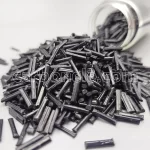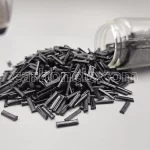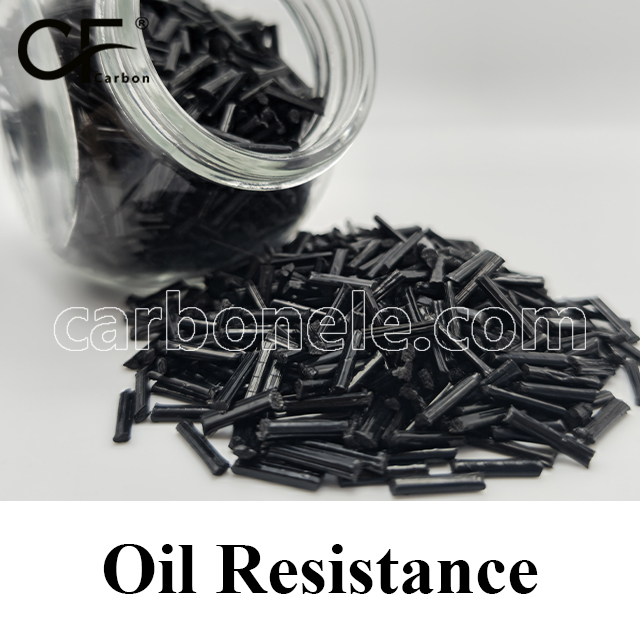
Conductive PA6 LCF40 Ageing Resistant Nylon 6 Composites
PA6 LCF40 is known for its excellent mechanical properties and durability. One critical aspect that enhances its applicability in various industries is its resistance to ageing, which ensures long-term performance under different environmental conditions.
- Manufacturer: Carbon New Material
- OEM/ODM: Acceptable
- Color: Black
- Free samples: ≤10kg
- MOQ: 100kg
- Port: Xiamen
- Model No.: PA6-LCF-BCA4
What are Ageing Resistant PA6 LCF40 Composites?
Ageing resistant PA6 LCF40 refers to polyamide 6 (PA6) composites reinforced with 40% long carbon fibers (LCF40) designed to withstand deterioration from environmental factors over time.
These composites exhibit exceptional resistance to thermal degradation, moisture absorption, UV radiation, and chemical exposure, ensuring prolonged durability and performance stability in various applications.
By incorporating additives like UV stabilizers and antioxidants, and optimizing fiber-matrix interactions, PA6 LCF40 maintains structural integrity and mechanical properties under harsh conditions.
This makes them suitable for critical applications in automotive, aerospace, and industrial sectors where reliability and longevity are essential requirements.
The composites are prized for their resilience against environmental ageing factors like heat, moisture, UV, and chemicals.
This durability makes them ideal for demanding applications in automotive, aerospace, and sporting goods industries.
Composition and Structure
PA6 LCF40 composites combine the toughness and flexibility of polyamide 6 with the high strength-to-weight ratio provided by long carbon fibers. The fibers are typically aligned in the polymer matrix, enhancing load-bearing capacity and stiffness while maintaining a lightweight profile. This composition is crucial in applications where both structural integrity and longevity are paramount.
Ageing Mechanisms and Challenges
Ageing in composite materials like PA6 LCF40 refers to the degradation or changes in properties over time due to environmental factors such as heat, moisture, UV exposure, and chemical exposure. These factors can lead to:
1. Thermal Degradation: High temperatures can cause polymer chains to break down, reducing mechanical strength and stiffness.
2. Moisture Absorption: PA6 is hygroscopic, meaning it absorbs moisture over time, which can weaken the material and affect dimensional stability.
3. UV Degradation: Exposure to ultraviolet (UV) radiation can lead to polymer chain scission and surface degradation, reducing the material’s strength and appearance.
4. Chemical Attack: Contact with chemicals such as acids, bases, and solvents can cause swelling, softening, or degradation of the composite matrix.
Enhancing Ageing Resistance
To mitigate these ageing effects and ensure the long-term performance of PA6 LCF40 composites, several strategies are employed:
1. Additive Incorporation: UV stabilizers and antioxidants are commonly added to the polymer matrix to enhance resistance to UV radiation and oxidative degradation.
2. Surface Treatments: Long carbon fibers can be treated to improve their bonding with the polymer matrix, reducing moisture absorption and enhancing overall durability.
3. Matrix Modification: Modifying the PA6 matrix with toughening agents or cross-linking agents can improve resistance to chemical attack and thermal degradation.
4. Design Considerations: Proper design, including geometry and thickness considerations, can minimize stress concentrations and improve overall durability.
Where to use them?
PA6 LCF40 composites find extensive use in industries requiring high-performance materials that can withstand harsh environmental conditions over extended periods. Some notable applications include:
– Automotive: Structural components, under-the-hood applications, and lightweight panels benefit from the high strength and heat resistance of PA6 LCF40% composites.
– Aerospace: Components in aircraft interiors and structural parts benefit from the lightweight nature and durability of these composites.
– Sporting Goods: Sporting equipment such as tennis racket frames and bicycle components utilize PA6 LCF40 for its strength and impact resistance.
The ageing resistant properties of PA6 LCF40% nylon 6 composites make them indispensable in industries where durability, mechanical strength, and long-term performance are critical.
Through careful formulation, additive incorporation, and structural design, these composites continue to evolve, meeting the demanding requirements of modern applications.
As research and development in composite materials advance, further enhancements in ageing resistance are expected, opening up new possibilities for their use across various sectors of industry and manufacturing.
For more info on long carbon fiber filled thermoplastic composites, please click here.
PA6 LCF40 CHARACTERISTICS
1. High strength-to-weight ratio due to 40% long carbon fiber reinforcement. 2. Excellent impact resistance and toughness. 3. Good dimensional stability and stiffness. 4. Resistant to moisture absorption. 5. Suitable for structural applications in automotive and aerospace industries.


Frequently Asked Questions
Carbon (Xiamen) New Material Co., Ltd. aims to provide buyers with "one-stop" worry-free high-quality services. Here you can find all information about carbon fiber engineering plastics. If you still have questions, please send us an email for consultation!
-
How can I contact the manufacturer of a product that interests me?
When you find a product you are interested in, you can contact the manufacturer directly by sending an email and we will get back to you as soon as possible.
-
How do I find the products that interest me?
All you need to do is enter the keyword, product name in the search window and press the Enter key on your keyboard. Your search results page will then be displayed. You can also search within the product category pages on the home page. Each category is divided into subcategories, allowing you to refine your search and find products that interest you.
-
Where will I find a buying guide?
Please contact our after-sales service directly and we will provide you with a comprehensive operating guide.
-
What are CF Reinforced Thermoplastic Composites?
CF Reinforced Thermoplastic Composites are materials where carbon fibers are incorporated into a thermoplastic matrix. They combine the strength and stiffness of carbon fibers with the processability and recyclability of thermoplastics. For instance, they are used in automotive parts like bumper beams.
-
What are the benefits of CF Reinforced Thermoplastic Composites over traditional composites?
The key benefits include faster production cycles, easier recyclability, and better impact resistance. They also offer design flexibility. An example is in the manufacturing of consumer electronics casings where complex shapes can be achieved more easily.
-
How are CF Reinforced Thermoplastic Composites processed?
Common processing methods include injection molding, extrusion, and compression molding. Injection molding is widely used for mass production. For example, in the production of small components for the medical industry.
-
What industries use CF Reinforced Thermoplastic Composites?
They are utilized in aerospace, automotive, medical, and sports equipment industries. In aerospace, they can be found in interior components. In the medical field, they might be used in prosthetics.
-
How does the carbon fiber content affect the properties of the composites?
Higher carbon fiber content generally leads to increased strength and stiffness but may reduce ductility. A moderate content is often balanced for specific applications. For example, a higher content might be preferred in structural parts of a race car.
-
What are the challenges in using CF Reinforced Thermoplastic Composites?
Challenges include higher material costs, complex processing equipment requirements, and ensuring uniform fiber dispersion. Issues with adhesion between the fibers and the matrix can also arise. An example is in achieving consistent quality in large-scale production.























